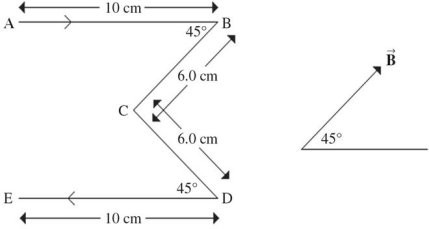Force on a Wire: A wire in the shape of an "M" lies in the plane of the paper. It carries a current of 2.0 A, flowing from A to E, as shown in the figure. It is placed in a uniform magnetic field of 0.55 T in the same plane, directed as shown on the right side of the figure. The figure indicates the dimensions of the wire. Note that AB is parallel to DE and to the baseline from which the magnetic field direction is measured. What are the magnitude and direction of the force acting on section CD of this wire?
A. 0.066 N perpendicular into the page
B. 0.40 N perpendicular out of the page
C. 0.066 N perpendicular out of the page
D. 0.40 N perpendicular into the page
E. 0.20 N perpendicular out of the page
Answer: C
You might also like to view...
Consider the cooling of (a) a personal computer with a separate CPU, and (b) a laptop computer. The reliable functioning of these machines depends upon their effective cooling. Identify and briefly explain all modes of heat transfer that are involved in the cooling process.
GIVEN - A personal computer with a separate CPU (the monitor, keyboard, and mouse are separate and not considered). - A laptop computer. FIND Identify and describe modes of heat transfer involved in their cooling. ASSUMPTIONS - The computers are turned on and in normal operation.
A single conservative force Fx = (6.0x ? 12) N (x is in m) acts on a particle moving along the x axis. The potential energy associated with this force is assigned a value of +20 J at x = 0 . What is the potential energy at x = 3.0 m?
a. +11 J b. +29 J c. +9.0 J d. ?9.0 J e. +20 J
The electric field at the surface of a positively charged conductor has a direction characterized by which of the following?
a. perpendicular outward and away from the charge b. at a 45° angle to the surface c. tangent to the surface d. perpendicular inward toward the charge
A conclusion of the Michelson-Morley experiments was that
A. interference of EM-waves does not happen. B. the ether doesn't exist. C. Galilean relativity holds. D. light has momentum. E. light has no momentum.